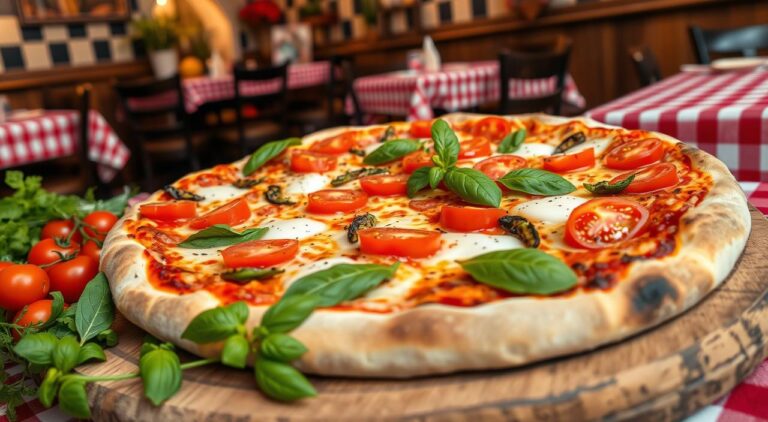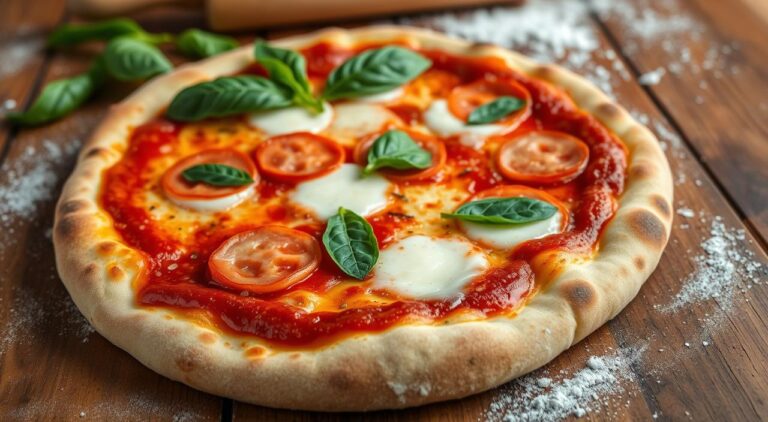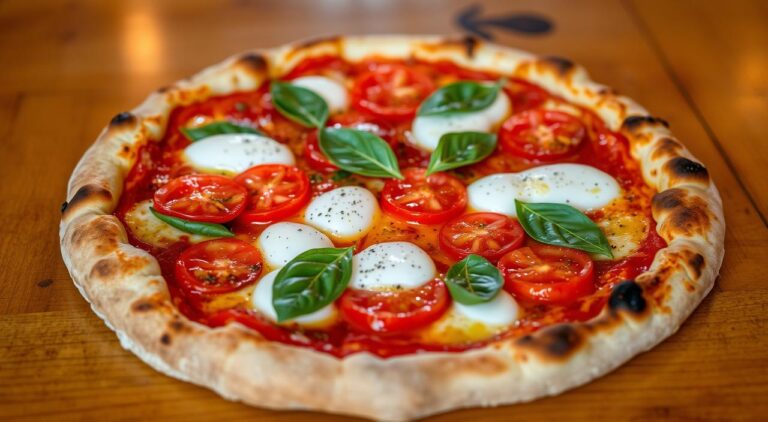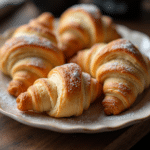Campanelle pasta is a standout in the world of Italian cuisine. Its unique, floral shape has won over pasta lovers everywhere. We’ll explore its origins, features, and tasty ways to enjoy it in this article.
Key Takeaways
- Campanelle pasta is an Italian pasta variety with a distinctive floral-like shape and ridged texture.
- The pasta originated in the Puglia region of Italy and has a long history dating back to the 19th century.
- Campanelle is made from semolina flour, water, and sometimes eggs, giving it a firm yet delicate texture.
- This versatile pasta can be found in both dried and fresh varieties, and comes in whole wheat and flavored options.
- Campanelle pairs well with a wide range of sauces, from hearty ragu to light and creamy varieties.
What is Campanelle Pasta?
Campanelle is a special type of short, ridged pasta from the Puglia region of Italy. Its name means “little bells” in Italian, fitting its flower-like shape. This shape comes from twisting and pinching the dough, making the surface rough. This roughness helps sauces stick to the campanelle pasta noodles.
Origin and History of Campanelle
The story of campanelle pasta begins in the Puglia region, known for its rich food traditions. This area is famous for its creative pasta shapes. The campanelle shape came from the region’s pasta-making skills. Artisans made each piece by hand, creating a unique and beautiful noodle.
Distinctive Floral Shape and Texture
Campanelle pasta is known for its striking floral shape. This look comes from twisting and pinching the dough. This method not only makes the pasta look special but also makes its campanelle texture unique.
The ridges on the noodles let sauces and other toppings stick well. This makes eating it even better.
“The campanelle shape is not just a pretty face – it serves an important purpose in pasta making, allowing sauces to perfectly coat each noodle.”
Ingredients and Production of Campanelle Pasta
The delightful campanelle pasta is made from a simple mix of ingredients. At its heart, campanelle pasta uses semolina flour. This flour is known for its coarse texture and rich, nutty taste. Water and sometimes a bit of egg are added to the dough. This makes the dough ready to be shaped into its unique form.
Making campanelle pasta is an art. The dough is molded into a shape like a small, ruffled bell or trumpet. This shape gives the pasta its special texture and lets sauces fill its nooks and crannies.
After shaping, the campanelle pasta is dried. This can be done the traditional way or with modern methods. Drying helps the pasta keep its shape and flavor, making it ready for many tasty Italian dishes.
The key to campanelle pasta is the quality of semolina flour and the careful shaping. These steps make the pasta not just beautiful but also delicious to eat.
Varieties of Campanelle Pasta
Classic semolina campanelle is a favorite, but there’s more to explore. Artisans now offer whole wheat and flavored or colored campanelle. These options are perfect for pasta lovers looking for something new.
Whole Wheat and Semolina Varieties
For those who care about health, whole wheat campanelle is a great pick. It has a nutty taste and a filling texture. This makes it a great choice for a nutritious meal.
Flavored and Colored Campanelle
If you want to try something different, check out flavored and colored campanelle. You can find it in spinach, tomato, or squid ink flavors. These types of campanelle pasta let you play with new tastes and textures.
| Variety | Ingredients | Flavor Profile |
|---|---|---|
| Whole Wheat Campanelle | Whole wheat flour, water | Nutty, hearty |
| Semolina Campanelle | Semolina flour, water | Classic, slightly nutty |
| Spinach Campanelle | Semolina flour, spinach, water | Earthy, vibrant green |
| Tomato Campanelle | Semolina flour, tomato, water | Tangy, vibrant red |
| Squid Ink Campanelle | Semolina flour, squid ink, water | Briny, deep black |
Whether you like whole wheat campanelle, the traditional semolina campanelle, or the unique flavored and colored campanelle, this pasta is versatile. It opens up a world of new dishes to try.
Cooking Campanelle Pasta
Preparing and cooking campanelle pasta needs some care to keep its delicate shape and texture. With the right techniques, you can enjoy its full flavor and appeal. This versatile pasta variety is worth the effort.
Preparation and Cooking Tips
To cook campanelle pasta right, follow these key tips:
- Use plenty of salted boiling water. This gives the pasta enough room to cook evenly.
- Cook the pasta al dente to keep its signature bite and shape. Don’t overcook it, or it will lose its unique ridges and shape.
- Drain the pasta carefully, handling it gently. This prevents the delicate campanelle from getting crushed or damaged.
- Toss the cooked campanelle with your desired sauce right away. This stops the noodles from sticking together.
By following these simple campanelle pasta preparation and cooking tips, you can highlight the best in this unique pasta. Whether you’re making a classic Italian dish or trying new flavors, properly cooked campanelle will always impress.
Campanelle Pasta Dishes
Campanelle pasta is known for its unique shape and great at holding onto sauces. It’s a key ingredient in classic Italian cooking. You can find it in dishes like traditional Bolognese or creamy pesto. It’s perfect for many Italian recipes.
Classic Italian Recipes
The Tuscan-style Campanelle with Pesto is a favorite. The pasta’s shape is ideal for holding the pesto’s flavors. It makes every bite a burst of taste.
For something more filling, try the Campanelle Pasta Bake. It mixes the pasta with tomato sauce, creamy béchamel, and melted cheese. It’s a comforting dish that’s sure to please.
“Campanelle pasta is the perfect vehicle for classic Italian sauces, from the bold flavors of Bolognese to the vibrant freshness of pesto.”
Campanelle pasta is great for both simple dishes and hearty casseroles. It’s a tasty way to enjoy Italy’s rich food traditions.

| Dish | Key Ingredients | Preparation |
|---|---|---|
| Campanelle with Pesto | Campanelle pasta, basil pesto, Parmesan cheese | Toss cooked campanelle with homemade or store-bought pesto and top with grated Parmesan. |
| Campanelle Pasta Bake | Campanelle pasta, tomato sauce, béchamel, mozzarella | Layer cooked campanelle with tomato sauce, béchamel, and shredded mozzarella, then bake until golden and bubbly. |
| Campanelle Bolognese | Campanelle pasta, ground beef, tomatoes, onions, carrots, celery | Sauté ground beef and vegetables, then simmer with tomatoes to create a classic Bolognese sauce. Toss with cooked campanelle. |
Campanelle Pasta and Sauces
Campanelle pasta has a unique, flower-like shape. It’s great with many sauces. The ridges and nooks hold onto the sauce, making every bite flavorful.
Pairing Campanelle with Sauces
Its textured surface is perfect for rich, tomato-based sauces. The sauce gets into the pasta’s nooks and crannies. Try it with classic Italian ragù or fresh tomato sauce. For a creamy twist, go for alfredo or carbonara.
Campanelle also pairs well with lighter sauces. Try it with vibrant pesto, garlic-herb sauces, or a lemon dressing. These sauces highlight the pasta’s light and airy texture.
| Sauce | Pairing with Campanelle |
|---|---|
| Tomato Sauce | Excellent, the sauce clings to the pasta’s ridges |
| Pesto | Works well with the pasta’s delicate texture |
| Alfredo | The creamy sauce complements the campanelle |
| Lemon Butter | Bright and light, allows the pasta’s flavor to shine |
“The unique shape of campanelle pasta allows it to hold on to sauces in a way that other pasta shapes simply can’t. It’s the perfect vehicle for showcasing bold, flavorful sauces.”
Nutritional Value of Campanelle Pasta
Campanelle is a semolina-based pasta. It’s a great source of complex carbs and moderate protein. It can also give you a boost of fiber, vitamins, and minerals, making it a nutritious meal choice.
Campanelle pasta’s nutritional value changes a bit depending on the ingredients. But, it’s mainly a good source of complex carbs. These carbs are slow to digest, giving you energy that lasts and making you feel full. Plus, the protein in campanelle supports muscle health and repair.
Some types of campanelle pasta are also high in dietary fiber. Fiber is key for a healthy gut and helps control blood sugar. Flavored or whole-wheat campanelle might also have extra vitamins and minerals like iron, folate, and B vitamins.
| Nutrient | Amount per 100g of Cooked Campanelle Pasta |
|---|---|
| Calories | 158 |
| Carbohydrates | 31g |
| Protein | 5.5g |
| Fiber | 2g |
| Iron | 1.3mg |
| Folate | 26μg |
Campanelle pasta is a nutritious choice for any balanced diet. It offers complex carbs, protein, and can have more nutrients based on the type. Its unique shape and versatility make it a great pick for pasta lovers.
Buying and Storing Campanelle Pasta
You can buy campanelle pasta in many stores, specialty shops, and online. You can get it in fresh and dried forms. Each type has its own benefits for cooking and how long it lasts.
Fresh vs. Dried Campanelle
Fresh campanelle pasta is great for those who like a soft texture and quick cooking. Dried campanelle pasta lasts longer and is good for your pantry. No matter which one you pick, storing it right is key to keeping it tasty and fresh.
| Fresh Campanelle Pasta | Dried Campanelle Pasta |
|---|---|
| Delicate texture | Firmer texture |
| Shorter cooking time | Longer cooking time |
| Shorter shelf life | Longer shelf life |
When storing campanelle pasta, whether it’s fresh or dried, use an airtight container in a cool, dry spot. This keeps the pasta’s texture good and stops it from drying out or going bad. Eat fresh campanelle pasta within a few days, and dried campanelle pasta can last for months.
“Campanelle pasta is a versatile ingredient that can elevate any dish, from classic Italian recipes to modern culinary creations.”
Homemade Campanelle Pasta
For those who love to create, making campanelle pasta at home is a fun project. It lets you control the ingredients and shape. This makes it a great activity for pasta lovers. With some skill and patience, you can make your own noodles and add a personal touch.
First, you mix high-quality flour, eggs, and water to make the dough. After kneading and resting, roll it out. Then, cut it into the campanelle shape with a special tool or by hand. Once done, boil the noodles and mix them with your favorite sauces and ingredients for a tasty dish.
Making homemade campanelle pasta is a unique way to enjoy cooking. It lets you get creative with flavors and textures. By making it yourself, you get to enjoy the process and the final delicious result.










